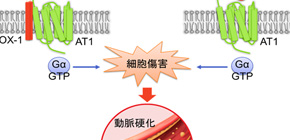
New mechanism of the receptor important for regulating blood pressure to damage arterial wall unveiled
A new link between arterial sclerosis and blood pressure regulation
A group led by Koichi Yamamoto (Lecturer, Graduates school of Medicine, Osaka University), in collaboration with Tatsuya Sawamura (Professor, Graduates school of Medicine, Shinshu University) and Akemi Kakino (Assistant professor, Graduates school of Medicine, Shinshu University) found that the angiotensin II *1 type 1 receptor (AT1 *2 ) that is important for regulating blood pressure can be activated by oxidized low density lipoprotein (LDL) *3 .
This is the first finding that a hormone that promotes hypertension, and oxidized lipid increased in patients with dyslipidemia share a single receptor to damage blood vessels. As it is conceivable that there are similar other systems that may cause the onset of aging-associated diseases, the development of the present research could lead to a discovery of new approach for such diseases.
Abstract
While angiotensin II is a peptide hormone that has an important role in maintaining blood pressure by contraction of arteries, the peptide has a negative effect in human body by inducing hypertension or damaging arterial walls. Drugs to suppress the production of angiotensin II or inhibit its receptor (AT1) are used as antihypertensives all over the world.
In patients with dyslipidemia, oxidation of increased bad cholesterol (LDL cholesterol) is a critical step to initiate atherosclerosis by damaging arterial walls. The lectin-like oxidized LDL receptor (LOX-1 *4 ), a receptor for oxidized LDL, increases on the surface of blood vessels in patients with several lifestyle-related diseases, and mediates vascular injury by binding to oxidized LDL. However, it has long been a mystery why binding of oxidized LDL to the receptor is associated with so many pathologic cell signaling events.
In the present study, the researchers have discovered that oxidized LDL robustly activates the AT1 and that such receptor activation triggers AT1 mediated signaling events and physiologically relevant vascular responses involved in the pathogenesis of cardiovascular disease. They have found that the mechanism depends on complexes between LOX-1 and AT1 on cell surface membranes and that oxidized LDL binding to LOX-1 triggers the activation of AT1 within LOX-1 - AT1 complexes. These findings revealed a novel pathway for activation of a key receptor (AT1) involved in cardiovascular disease pathogenesis and uncovered a heretofore unrecognized mechanism whereby oxidized LDL could contribute to risk for atherosclerosis.
These studies have identified a novel pathway whereby oxidized LDL cholesterol could contribute to the pathogenesis of cardiovascular disease. Thus, the findings may lead to improved pharmacologic approaches to the prevention and treatment of cardiovascular disease in the many patients with high cholesterol levels who are unable to tolerate conventional lipid-lowering therapies.
*1. angiotensin II: A circulating hormone that increases blood pressure by contracting arteries and retaining sodium in a body. It may cause atherosclerosis by damaging blood vessels.
*2. AT1: A receptor that exists on cell surface membrane and binds to angiotensin II. Its activation contracts blood vessels, but may damage arteries.
*3. oxidized LDL: A waste product generated by oxidation of low density lipoprotein (LDL) in a body. It induces atherosclerosis by being engulfed by macrophage, or by directly damaging arteries via a mechanism as shown here.
*4. LOX-1: A receptor that exists on cell surface membrane and binds to oxidized LDL. It increases in patients with several lifestyle-related diseases, and induces atherosclerosis.
Figure 1. Newly identified mechanism of oxidized LDL to induce atherosclerosis
To learn more about this research, please view the full research report entitled “ Oxidized LDL (oxLDL) activates the angiotensin II type 1 receptor by binding to the lectin-like oxLDL receptor ” at this page of the FASEB Journal website.
Related link

